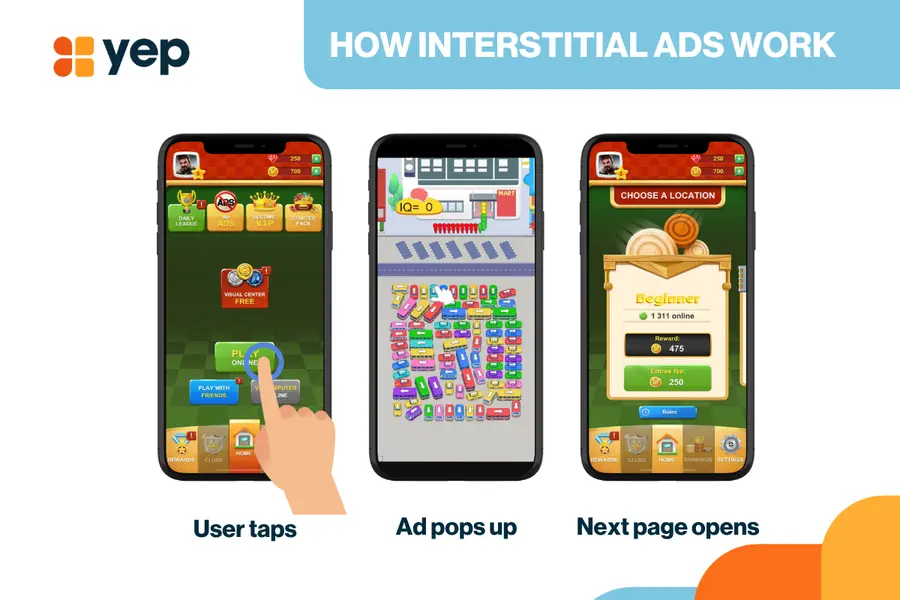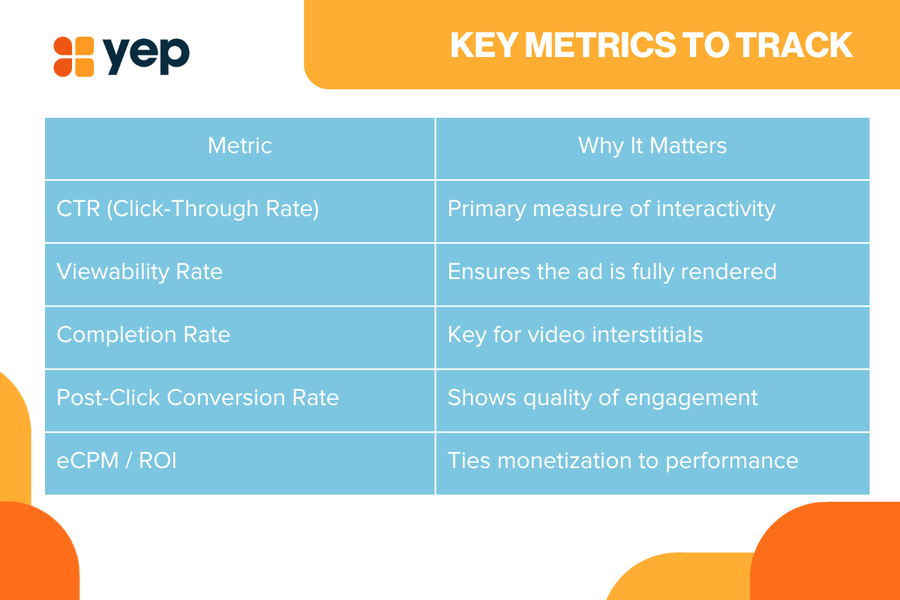
What Are Interstitial Ads? The 2025 Guide for Affiliates & Media Buyers
Ever tapped “next level” in a game and suddenly, boom, a full-screen ad appears?
That’s an interstitial ad, and when used right, it can be one of the most powerful ad formats out there.
These ads have evolved far beyond pop-ups or static banners. In 2025, they’re dynamic, data-driven, and can be strategically timed to appear at just the right moment. Let’s break down how they work, why they convert so well, and what you should know before adding them to your traffic strategy.

Основные выводы
- Interstitial ads are full-screen, interactive placements that appear at natural breaks in a user’s journey (like between game levels or page transitions).
- They deliver high engagement and visibility thanks to their immersive format but they must follow Google’s UX and timing guidelines to avoid penalties.
- Interstitials can appear across mobile apps, mobile web, and desktop, though mobile dominates performance results.
- Creative design, placement, and frequency determine success. Poorly timed interstitials = user frustration.
- With programmatic platforms and AI optimization, interstitials are now smarter, better targeted, and easier to A/B test than ever before.
Оглавление
- What Are Interstitial Ads?
- How Interstitial Ads Work
- Interstitials vs. Pop-Ups vs. Rewarded Ads
- Where You Can Use Interstitial Ads (App, Mobile, Desktop)
- Benefits for Advertisers
- Benefits for Publishers
- Google’s Policy on Intrusive Interstitials
- Best Practices: Placement, Frequency & Design
- Creative Strategies That Work in 2025
- Key Metrics to Track for Success
- Заключительные размышления
- Вопросы и ответы
What Are Interstitial Ads?
Interstitial ads are full-screen placements that appear during natural breaks in user activity, like switching between pages, loading a new level, or finishing a video.
They take over the entire screen and typically offer two choices: engage with the ad or close it to continue.
Unlike banners or pop-ups, interstitials feel like part of the experience when done correctly. They can showcase static visuals, video clips, or rich media (such as interactive mini-experiences, swipe galleries, etc.).
How Interstitial Ads Work
Interstitials are designed to show up at natural “pause” moments and not when someone’s in the middle of doing something important. Think of them like little commercial breaks.
They can appear:
- Between game levels (right after you finish a round, not while you’re still playing)
- Between articles (after you scroll to the end of one, before you start the next)
- Before or after a video loads (so you’re not interrupting the video itself)
When the ad appears, the user can click, tap, or swipe to learn more or just close it and move on. Most video interstitials give a short wait time (about five seconds) before you can hit “Skip,” which keeps things fair for both the advertiser and the user.
A good interstitial feels like a short, well-timed break: it loads quickly, has a clear close button, and maybe even catches your interest enough to click.
A bad one, on the other hand, pops up out of nowhere while you’re in the middle of something, makes you wait too long to skip, or repeats over and over until it gets annoying. The key is to balance the best interstitials that fit naturally into the flow, giving users control while still giving brands a moment to shine.
Interstitials vs. Pop-Ups vs. Rewarded Ads
Here’s how they differ:

Совет профессионала: If you’re running mobile app traffic, consider testing rewarded interstitials users watch the ad by choice in exchange for in-app bonuses. These often have the highest engagement and retention rates.
Where You Can Use Interstitial Ads
Мобильные приложения
The most common use case. Ads appear between screens (like level loads or scene transitions).
They’re highly engaging and perfect for brand awareness or app install campaigns.
Mobile Websites
These display between page loads, ideal for monetizing content-heavy sites. However, avoid showing them immediately upon landing; that’s a violation of Google’s policy. Wait for a user action or transition.
Desktop Sites
Desktop interstitials are rarer today, but still useful for subscription offers or product launches. Because desktop browsing feels more “task-based,” timing is even more critical to avoid annoyance.
Benefits for Advertisers
- Visibility: Full-screen = 100% attention.
- High CTR: They consistently outperform banners in both click-through and engagement.
- Creative Freedom: Use motion, video, or interactivity.
- Cross-Device Reach: Works across app, web, and even gaming environments.
- Brand Impact: Full-screen visuals create better recall and post-click engagement.
Benefits for Publishers
- Premium Inventory: Advertisers pay top CPMs for full-screen visibility.
- Frequency Control: Publishers can set limits to protect UX.
- Flexible Monetization: Works with direct deals, programmatic exchanges, or affiliate offers.
- Better User Flow: When placed between actions, they feel like part of the experience, not a disruption.
When done right, interstitials turn natural app breaks into micro-monetization moments.
Google’s Policy on Intrusive Interstitials
To keep users happy, Google has strict rules about when and how interstitials can appear. Violating these can lead to ranking drops or ad penalties.
Avoid these mistakes:
- Showing interstitials right after a page loads or before exit
- Requiring users to dismiss an ad before accessing content
- Blocking search-intent content (like showing an ad when someone clicks a Google result)
- Showing an interstitial after every single page view
Allowed uses:
- Cookie consent or age verification screens
- Paywalls or login prompts
- Legal compliance messages
Think of it this way: if it frustrates users, Google will notice.
Best Practices: Placement, Frequency & Design
- Choose natural breaks.
Between content, not during it. Use A/B testing to find your best trigger points. - Keep frequency reasonable.
One interstitial every few minutes or after major interactions, not every tap. - Design for control.
Always include a clear “X” or skip button. Users should never feel trapped. - Test load times.
A heavy interstitial can ruin app performance. Compress video files and preload assets. - Track engagement, not just impressions.
Monitor CTR, completion rate, and dwell time to measure quality.
Creative Strategies That Work in 2025
Interstitial ads have come a long way from simple static screens. In 2025, creativity is all about being smart, quick, and relevant. Here’s what Yep Ads partners shared is working the best right now and why.
AI-Generated Visual Variations
Instead of guessing which design will perform better, AI now creates and tests multiple versions of the same ad, adjusting things like colour, copy, or layout depending on the device, time of day, or even weather. For example, showing a sunny summer image in California and a cozy winter scene in Toronto. It saves time and keeps campaigns feeling fresh everywhere.
Motion + Minimalism
Clean, short animations always win. A simple five-second motion clip with one clear message will almost always beat a busy graphic with too much text. Think sleek transitions, strong branding, and one focus point. That’s what keeps users watching instead of closing.
Countdown Timers
Nothing drives clicks like a bit of urgency. A countdown that says “Ends in 2 hours” or “Only 3 left” gives users a reason to act right now without feeling pressured. It’s simple psychology: urgency sells, especially during flash sales or Black Friday campaigns.
Sound-Off Autoplay
Most people scroll or play with their phone on silent, so your ad should still make sense without audio. The best interstitials use captions, visuals, or expressive motion to get the message across instantly, even if the sound’s off.
Personalization That Feels Natural
A small touch like “Chicago shoppers, this one’s for you” or “Shop before midnight to get free delivery” can boost engagement by up to 40%. It makes the ad feel personal and relevant, not generic. The key is to keep it subtle; friendly reminders work better than over-the-top urgency.

Key Metrics to Track
You can’t improve what you don’t measure and with interstitials, performance depends on more than just clicks. Here’s what really matters when you’re tracking results:
Impressions
How many times has your ad been shown? Great for checking reach, but don’t stop here, pair it with clicks to see real engagement.
CTR (Click-Through Rate)
Shows how many people clicked after seeing your ad. If it’s low, your creativity or timing might need a refresh.
CVR (Conversion Rate)
Tells you how many clicks turned into actions, like signups or sales. A high CTR but low CVR usually means your landing page isn’t matching user expectations.
Engagement Time
For videos, check how long people stay before skipping. If they leave fast, tighten your intro or make visuals more eye-catching.
Frequency
Tracks how often users see your ad. Too many repeats feel annoying; too few, and they might forget you. Aim for balance.
Revenue or eCPM
Shows how much you earn per thousand impressions. Perfect for understanding what’s really paying off.
In short, look at the full picture. High clicks mean attention, but conversions show trust. Track both to see what’s truly working.
Заключительные размышления
Interstitial ads can deliver exceptional performance if they respect the user journey.
They combine visibility, flexibility, and conversion power, making them a strong choice for affiliates, app developers, and performance marketers alike.
But timing, design, and compliance make or break results. Treat interstitials as part of your brand experience, not a disruption.
На сайте Мы, we help brands and affiliates scale with formats that perform from in-app interstitials to native, video, and rewarded placements across 140+ countries.
FAQs About Interstitial Ads
- What are interstitial ads?
They’re full-screen, interactive ads shown at natural breaks in user activity in apps, mobile sites, or desktops. - How are interstitials different from pop-ups?
Pop-ups overlay small parts of a page; interstitials take over the full screen and are timed more intentionally. - Where can I use them?
Apps, mobile websites, and desktop pages with multiple transitions avoid single-page scroll sites. - Are interstitials mobile-only?
No. Mobile drives most performance, but desktop versions work for longer-session content or subscriptions. - Are interstitials intrusive?
Not when placed correctly. The key is timing, they should feel like part of the journey, not an interruption. - What happens if I misuse them?
Google may penalize your site in search rankings or ad visibility. Always follow UX best practices. - What’s the best way to test interstitials?
A/B test placement, duration, and design. Check analytics for CTR, completion, and bounce rate to refine performance.
